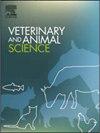尼泊尔Chitwan国家公园圈养的一岁大鳄鱼(Gavialis gangeticus)的结肠杆菌、沙门氏菌和葡萄球菌的鉴定和多药耐药谱
IF 1.9
Q2 AGRICULTURE, DAIRY & ANIMAL SCIENCE
引用次数: 0
摘要
本研究的重点是在尼泊尔Chitwan国家公园的鳄鱼繁殖中心,从圈养的一岁大的鳄鱼(Gavialis gangeticus)的肛门棉签中分离出大肠杆菌、沙门氏菌和葡萄球菌的鉴定和抗生素谱。共采集28份样品,分离出38株,其中大肠杆菌(46.43%)、葡萄球菌(46.43%)和沙门氏菌(42.86%)。14.29%的样品中分离出3种细菌。采用Kirby-Bauer圆盘扩散法进行的抗菌药物敏感性试验表明,对氨苄西林和环丙沙星等常用抗生素具有高度耐药性。多药耐药现象普遍存在,84.62%的大肠杆菌和58.33%的沙门氏菌分离株被列为多药耐药,而所有葡萄球菌分离株均显示出对三种或三种以上抗生素的耐药,这突显了严重的抗菌素耐药性挑战。该研究还揭示了爬行动物肠道微生物群与环境因素之间的重要相互作用,表明细菌传播的共同宿主。研究结果强调,迫切需要进行抗菌素管理、改善环境管理和定期健康监测,以减轻极度濒危的鳄鱼的抗菌素耐药性和致病菌带来的风险。这项研究为圈养鳄鱼面临的健康挑战提供了有价值的见解,并为制定有针对性的保护策略提供了基础。本文章由计算机程序翻译,如有差异,请以英文原文为准。
Identification and multidrug resistance profiles of Escherichia coli, Salmonella, and Staphylococcus from cloacal swabs of captive yearling gharials (Gavialis gangeticus) in Chitwan National Park, Nepal
This study focuses on the identification and antibiogram profiles of Escherichia coli, Salmonella spp., and Staphylococcus spp. isolated from cloacal swabs of captive yearling gharials (Gavialis gangeticus) at the Gharial Breeding Center, Chitwan National Park, Nepal. A total of 28 samples were collected and processed, yielding 38 isolates comprising E. coli (46.43 %), Staphylococcus spp. (46.43 %), and Salmonella spp. (42.86 %). All three bacteria were isolated in 14.29 % of samples. Antimicrobial susceptibility testing, performed using the Kirby-Bauer disk diffusion method, demonstrated high levels of resistance to commonly used antibiotics such as ampicillin and ciprofloxacin. Multidrug resistance was prevalent, with 84.62 % of E. coli and 58.33 % of Salmonella spp. isolates classified as multidrug-resistant, while all Staphylococcus spp. isolates showed resistance to three or more classes of antibiotics underscoring critical AMR challenges. The study also revealed a significant interplay between the reptilian gut microbiota and environmental factors, suggesting shared reservoirs for bacterial transmission. The findings underscore the urgent need for antimicrobial stewardship, improved environmental management, and regular health monitoring to mitigate the risks posed by antimicrobial resistance and pathogenic bacteria in critically endangered gharials. This research contributes valuable insights into the health challenges facing captive gharials and provides a basis for developing targeted conservation strategies.
求助全文
通过发布文献求助,成功后即可免费获取论文全文。
去求助
来源期刊

Veterinary and Animal Science
Veterinary-Veterinary (all)
CiteScore
3.50
自引率
0.00%
发文量
43
审稿时长
47 days
 求助内容:
求助内容: 应助结果提醒方式:
应助结果提醒方式:


